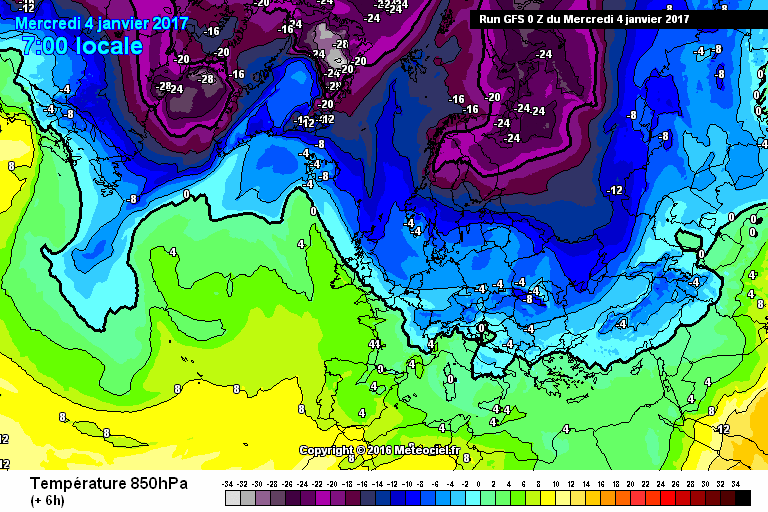Das strahlende Hoch zum Jahreswechsel wurde in der Nacht auf Dienstag von einer maskierten Kaltfront abgelöst, die dem Norden ein paar Zentimeter Schnee bescherte. Eine maskierte Kaltfront ist eine normale Kaltfront, die nur in höheren Luftschichten für eine Abkühlung sorgt, während es am Boden wärmer wird. Das ist dann der Fall, wenn die bodennahe Luft bei einer Inversionslage stark auskühlt und mit Frontaufzug und damit einhergehendem Wind ausgeräumt und durch – relativ – wärmere Luft ersetzt wird. So ist die Kaltfront nicht zu erkennen und sie kann in Ruhe Tankstellen überfallen, oder so.
WetterBlog 10 2016/17 | Arktischer Ausbrecher
Hintergründe zum Alarm...
500hPa Geopotential und Bodendruck am heutigen Mittwoch, 4.1. Meridionale Lage mit Hoch im Westen und kräftigem Tief im Bereich Ostsee. Dazwischen stake N Anströmung.
Jedenfalls ist also das Hoch erstmal weg. Auf die Kaltfront folgte am gestrigen Dienstag zwar ruhiges Wetter, aber der Winter stand schon in den Startlöchern: Ein kleines, abgetropftes Tief im Atlantik stützt das Hoch vor der Westküste Europas, in dem es warme Luft nach Norden lenkt. Über der Ostsee liegt ein Sturmtief mit sehr tiefem Kern. Zwischen dem Atlantikhoch und dem Tief entwickelt sich eine starke, stürmische Nordströmung. Mit Ankunft eines in das Ostseetief eingelagerten Frontensystems setzt an der Alpennordseite der Niederschlag ein.
Das Ostseetief zapft arktische Kälte an und schaufelt sie bis nach Mitteleuropa. Am Donnerstag kippt die Achse des Atlantikhochs ein wenig nach Osten und die Anströmung in den Ostalpen erhält eine östliche Komponente, wodurch weitere Kaltluft herbei geschoben wird. Die Temperaturen von Donnerstag bis Samstag werden auf jeden Fall empfindlich kalt wie lange nicht. Sowas nennt sich Arctic Outbreak – der Ausbrecher aus dem arktischen Gefängnis könnte sich mit der maskierten Kaltfront zusammen tun und eine winterliche Gang bilden.
Mittelfrist
Wie es ab dem Wochenende genau weiter geht, ist noch mit ein paar Unsicherheiten behaftet. Aus heutiger Sicht wird es am Freitag relativ sonnig, während es am Samstag im Norden bereits wieder zu zieht. Derzeit sieht es so aus, als würde sich für die nächste Zeit eine Nordwestlage etablieren. Das Atlantikhoch wird von einem Tief mit Kern östlich von Grönland quasi überfahren und die Anströmung wird zonaler. Damit würde es mit der Zufuhr atlantischer Luftmassen wieder milder, bliebe aber feucht mit weiteren Schneefällen im Norden und Westen bis in die nächste Woche hinein.
Für die Südalpen sieht es schneemäßig weiterhin nicht besonders gut aus. Die Balkanländer, Griechenland, Teile Süditaliens und der Westen der Türkei dürften dank einem Balkantief hingegen wieder einiges an Niederschlag abbekommen. Eventuell ist für die Italienische Adriaküste im Zuge dessen auch Sea-Effect Schnee drin (= die große Variante vom Lake Effect).
Nicht vergessen: Schneehöhentipp für den aktuellen Alarm abgeben!

Temperaturen in 850hPa. Der lila Blob, der aus NO nach Mitteleuropa tropft ist der Arctic Outbreak. Grafik anklicken falls sich das GIF nicht bewegt.
Temperaturen in 850hPa. Der lila Blob, der aus NO nach Mitteleuropa tropft ist der Arctic Outbreak. Grafik anklicken falls sich das GIF nicht bewegt.
Fotogalerie
-

Wetterverlauf an der Station Grimming (STMK). Mit eintreffen der maskierten Kaltfront steigt die Temperatur in Tal (lila Linie, 643m) weil die Inversion ausgeräumt wird. In der Höhe hingegen sinkt die Temperatur (rote Linien >2100m).
lawis.at -

500hPa Geopotential und Bodendruck am heutigen Mittwoch, 4.1. Meridionale Lage mit Hoch im Westen und kräftigem Tief im Bereich Ostsee. Dazwischen stake N Anströmung.
meteociel.fr -

500hPa Geopotential und Bodendruck am Freitag, 6.1. Die Achslage kippt etwas und die Nordanströmung bekommt eine östliche Komponente - optimale Rutschbahn für arktische Luftmassen...
meteociel.fr -

500hPa Geopotential und Bodendruck, exemplarische Karte für kommenden Montag, 9.1. Das Hoch im Westen reicht nicht mehr so weit in den Norden, die Strömung wird zonaler, Option auf NW Lage. Balkantief präsent.
meteociel.fr -

Anomalie (cm) der aktuellen Schneehöhe im Vergleich zum Mittel der Periode 1998/99-2011/12. Basiert auf Schnehöhenmessungen und einem Modell. Ungewöhnlich viel Schnee in der Westhälfte der Türkei.
https://www.ccin.ca/home/ccw/snow/current -
Anzeige
Ähnliche Artikel
-
PowderAlarm 7 2016/17 | Schnee in den Nordalpen
02.01.2017 • Lars Oelmann Endlich. Es ist so weit: es gibt einen echten Nordstau in - fast - den ganzen Nordalpen. Das heißt für viele Gebiete von der Zentralschweiz bis Tirol, dass der erste echte Schneefall am 5.1. der Saison kommt. Oha! Das heißt auch: nicht vergessen in den Frühsaisonsmodus zu schalten. Von der Schneedecke her haben wir hier gefühlt nämlich eher Anfang/Mitte November. Weiter im Osten gibt es bereits eine gewisse Unterlage und Ullr serviert euch nochmal Powder. Ihr könnt tatsächlich „richtig" Freeriden gehen.
Endlich. Es ist so weit: es gibt einen echten Nordstau in - fast - den ganzen Nordalpen. Das heißt für viele Gebiete von der Zentralschweiz bis Tirol, dass der erste echte Schneefall am 5.1. der Saison kommt. Oha! Das heißt auch: nicht vergessen in den Frühsaisonsmodus zu schalten. Von der Schneedecke her haben wir hier gefühlt nämlich eher Anfang/Mitte November. Weiter im Osten gibt es bereits eine gewisse Unterlage und Ullr serviert euch nochmal Powder. Ihr könnt tatsächlich „richtig" Freeriden gehen. -
WetterBlog 9 2016/17 | Details zum Alarm
27.12.2016 • Lea Hartl Warum kriegt nur der Osten was vom PowderAlarm ab? Was passiert danach? Was ist mit der möglichen Wetterumstellung zum Jahreswechsel?
Warum kriegt nur der Osten was vom PowderAlarm ab? Was passiert danach? Was ist mit der möglichen Wetterumstellung zum Jahreswechsel? -
PowderAlarm 6 2016/17 | Ullrs Wiener Melange
26.12.2016 • Lars Oelmann Wenn Ullr für den Buslenker an der Trafik eine Melange und einen Schneefall um fünf Euro bestellt, wisst ihr, dass es nur im Osten Österreichs schneien wird.
Wenn Ullr für den Buslenker an der Trafik eine Melange und einen Schneefall um fünf Euro bestellt, wisst ihr, dass es nur im Osten Österreichs schneien wird.
Kommentare
-
Uhr
